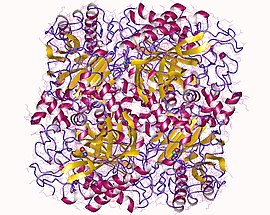In enzymology, a formamidase (EC 3.5.1.49) is an enzyme that catalyzes the chemical reaction
| formamidase | |||||||||
|---|---|---|---|---|---|---|---|---|---|
 Formamidase hexamer, Helicobacter pylori | |||||||||
| Identifiers | |||||||||
| EC no. | 3.5.1.49 | ||||||||
| CAS no. | 9013-59-6 | ||||||||
| Databases | |||||||||
| IntEnz | IntEnz view | ||||||||
| BRENDA | BRENDA entry | ||||||||
| ExPASy | NiceZyme view | ||||||||
| KEGG | KEGG entry | ||||||||
| MetaCyc | metabolic pathway | ||||||||
| PRIAM | profile | ||||||||
| PDB structures | RCSB PDB PDBe PDBsum | ||||||||
| Gene Ontology | AmiGO / QuickGO | ||||||||
| |||||||||
- formamide + H2O formate + NH3
Thus, the two substrates of this enzyme are formamide and H2O, whereas its two products are formate and NH3.
This enzyme belongs to the family of hydrolases, those acting on carbon-nitrogen bonds other than peptide bonds, specifically in linear amides. The systematic name of this enzyme class is formamide amidohydrolase. This enzyme participates in glyoxylate and dicarboxylate metabolism and nitrogen metabolism.
Structural studies
editAs of late 2007, four structures have been solved for this class of enzymes, with PDB accession codes 2DYU, 2DYV, 2E2K, and 2E2L.
References
edit- Clarke PH (1970). "The aliphatic amidases of Pseudomonas aeruginosa". Adv. Microb. Physiol. Advances in Microbial Physiology. 4: 179–222. doi:10.1016/S0065-2911(08)60442-7. ISBN 978-0-12-027704-9.
- Friedrich CG, Mitrenga G (1981). "Utilization of aliphatic amides and formation of two different amidases by Alcaligenes eutrophus". J. Gen. Microbiol. 125 (2): 367–374. doi:10.1099/00221287-125-2-367.
